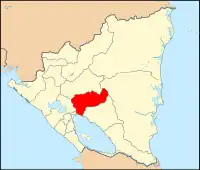 |
|---|
|
|
Nicaragua is a unitary republic, divided for administrative purposes into fifteen departments (Spanish: departamentos) and two autonomous regions (Spanish: regiones autónomas):
| ISO | Map | Department or autonomous region | Capital | Population (2015) | Area (km2) | Pop. density (km−2) |
|---|---|---|---|---|---|---|
| NI-BO | 
|
Boaco | Boaco | 178,582 | 4,176.68 | 41.8 |
| NI-CA | 
|
Carazo | Jinotepe | 190,769 | 1,081.40 | 172.8 |
| NI-CI | 
|
Chinandega | Chinandega | 429,557 | 4,822.42 | 87.7 |
| NI-CO | 
|
Chontales | Juigalpa | 185,866 | 6,481.27 | 24 |
| NI-ES | 
|
Estelí | Estelí | 224,331 | 2,229.69 | 90 |
| NI-GR | 
|
Granada | Granada | 206,009 | 1,039.68 | 162 |
| NI-JI | 
|
Jinotega | Jinotega | 438,413 | 9,222.40 | 36 |
| NI-LE | 
|
León | León | 410,860 | 5,138.03 | 69 |
| NI-MD | 
|
Madriz | Somoto | 164,146 | 1,708.23 | 78 |
| NI-MN | 
|
Managua | Managua | 1,484,462 | 3,465.10 | 365 |
| NI-MS | 
|
Masaya | Masaya | 364,168 | 610.78 | 475 |
| NI-MT | 
|
Matagalpa | Matagalpa | 561,282 | 6,803.86 | 69 |
| NI-NS | 
|
Nueva Segovia | Ocotal | 253,489 | 3,491.28 | 60 |
| NI-RI | 
|
Rivas | Rivas | 177,668 | 2,161.82 | 72 |
| NI-SJ | 
|
Río San Juan | San Carlos | 127,225 | 7,543.30 | 13 |
| NI-AN | 
|
North Caribbean Coast Autonomous Region | Bilwi | 480,874 | 33,105.98 | 10 |
| NI-AS | 
|
South Caribbean Coast Autonomous Region | Bluefields | 385,102 | 27,260.02 | 11 |
Autonomous regions
In 1987, the new constitution established the Charter of Autonomy (limited self-government) for the former department of Zelaya, comprising the entire eastern half of the country. The department was divided into two autonomous regions (communities): the North Caribbean Coast Autonomous Region and the South Caribbean Coast Autonomous Region. The Charter of Autonomy is largely based on the model used by Spain. The communities are governed by a Governor and a Regional Council.[1]
See also
Notes
- ↑ Clarisa Indiana Ibarra Rivera. "El modelo de justicia en las regiones autónomas de la costa Caribe nicaragüense: ¿utopia o realidad?" (PDF). corteidh.or.cr. Retrieved 29 November 2022.
- Instituto Nicaragüense de Estudios Territoriales (INETER). División Política Administrativa del País. March, 2000.
- Instituto Nicaragüense de Fomento Municipal (INIFOM). Municipios – General.
- International Organization for Standardization (ISO). Codes for the representation of names of countries and their subdivisions. ISO 3166-2:NI.
This article is issued from Wikipedia. The text is licensed under Creative Commons - Attribution - Sharealike. Additional terms may apply for the media files.
.svg.png.webp)